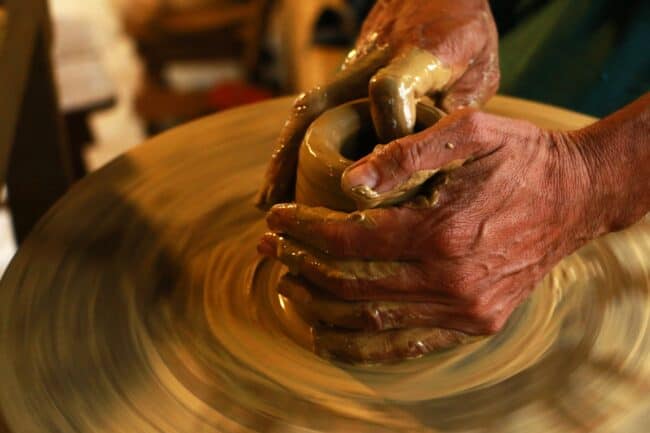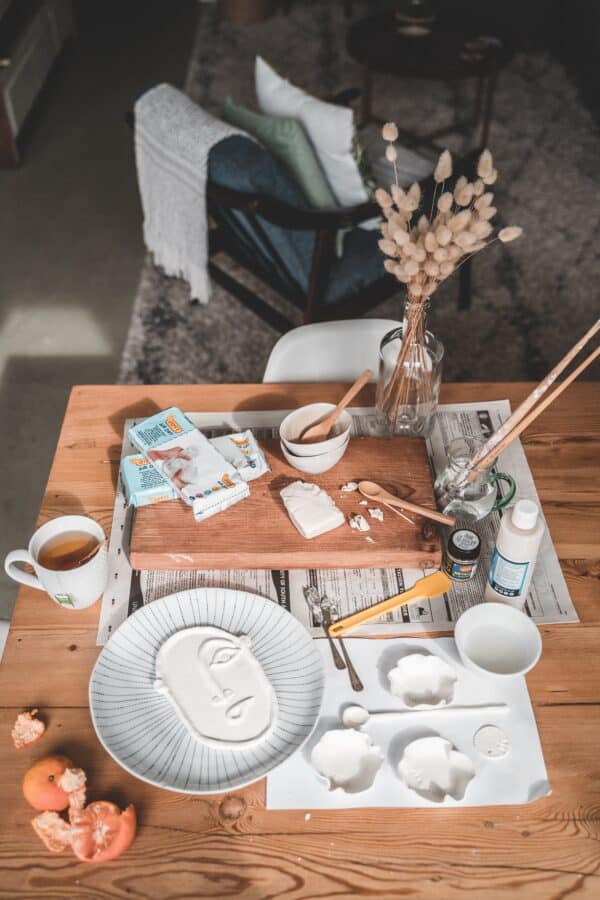Avoid These 9 Pottery Making Mistakes to Make your Creativity Flourish
Is your clay too dry or too wet?— both mistakes make it hard to give your pottery pieces proper shapes. Learn about nine pottery mistakes to avoid to make your creativity flourish
Pottery is the art of turning clay into creative vessels, pots, tubs, vases, and even beautiful ornaments. However, it’s enduring process always has some fallible aspects.
No matter how proficient you are, you’ll make some mistakes, or some imperfections will remain. However, since pottery is the limitless endeavor of innovatively turning the earth into various forms, you must know what mistakes to avoid.
Avoiding these mistakes will help you your creativity flourish, and will ensure minimum loss of materials and time.
If you have been facing some problems and imperfections in your pottery work here are some of the underlying mistakes and how you can avoid them.
1. Using the Wrong Type of Clay
You may choose from a range of pottery-friendly clay types, such as ball clay, earthen clay, stoneware clay, porcelain, etc. You must have seen those ceramic painting ideas posts on the internet. They actually show what you can do with the right type of clay.
The most basic mistake you can make with your pottery work is selecting the wrong type of clay for your project.
You may not think of it as a big mishap, but it will definitely affect your end product. Choosing the wrong clay type can blunder the entire pottery creation.
There may remain incompleteness in your design due to inappropriate burning, surfaces may smudge, clay may come off, or water may leak from the vessel due to the wrong clay.
2. Burning the Object Incorrectly
It doesn’t matter how long you burn your clay or what type of clay you use as the main material; it will come out wet or faulty if the fire temperature isn’t optimum.
A lot of potters make the mistake of neglecting the firing temperature. It might appear that you’re burning your vessels, pots etc correctly; however, you won’t notice the mishap until you remove them from the furnace.
If you are worried about your firing process, apply the following:
- Use a kiln furnace with the facility of temperature adjustment.
- Consider cranking the pottery object upon noticing wetness on the surface, requiring a higher burning temperature.
- Consider placing the furnace or firing place in a safer zone to avoid any sort of accidents or breaking of the pottery pieces.
3. Upholding the Clay in Wrong Ways
Wedging or upholding the clay is probably the most challenging part of the pottery work. It’s all about balancing, sharp observation, and masterfully curving the desired designs on the clay objects.
Working with the earthen doughs isn’t just about making them into a ball and throwing them into the wheel. Here, you must be very stable and careful. Hastening the process may end up in a mess.
Not wedging the clay will make it difficult for you to center the clay. Centering the clay is essential in giving your clay the desired form.
It’s because a wobbly wedging will most likely create air pockets in your clay, making your center go off-course. Make sure you don’t waste your time with the faulty clay, rather take another clay and wedge it correctly before giving it a form.
4. Clay Isn’t Moist Enough
While keeping the clay too wet can be a problem, it’s also a problem to keep it too dry. Lacking moisture in your clay will make its surface harder, often making it difficult to give the required shape along with the right design.
You can detect the dryness in your clay as you handle it in your hands. If your hands feel too dry or hard on the surface of the piece of clay, it’s not moistened enough.
To avoid any incorrectness in the design or shape due to this dryness, you have to take the clay off the wheel immediately, water it again, and then try to shape it from the beginning. Aptly watered clay can stay in the center of the wheel, making it easier for you to work with it.
5. Wrong Sitting Position
Pottery may be a challenging side hustle you can do from home, but with proper posture, you can ease the task significantly.
It is not just the lack of moisture or being too dry that causes a misshaped pottery work.
One of the most common reasons behind failing to get the desired shape and size of the clay is your wrong sitting position. If your arm position isn’t right, it can contribute to the wrong results.
Here are a few tips on setting your sitting and arm positions correctly while working with a piece of clay:
-
- Keep your legs very close to the splash pan.
- Sit straight while keeping your arms by the side of your body.
- Don’t just move your arms and hands; move your upper body in balance.
- You may lean over while keeping your back straight as much as possible.
6. Pressing on the Wall With Force
There are two phases of working with the clay wall. The first when you center the clay. And the second is when you try to pull up the wall. Pottery-making mistakes can be seen in both of these phases.
When you are centering the clay, don’t use too much force. It’s often the excessive pressure that pushes the clay off center.
Keeping your anchor hands steady is the key in this case. Using your anchor hands to exert too much pressure will only work you out instead of getting the appropriate center.
When it comes to pulling the wall off the clay, pulling it hard may make it uneven. The harder you pull, the faster it will become uneven.
Doing so will make the clay very fragile or thin in the bottom, middle, or on upper side. The only way to prevent this is not to squeeze the clay too hard and let it revolve on the wheel as evenly as possible.
7. Opening the Clay Fast
Pottery work should be steady and balanced. You should not be hastening or rushing your work. When you are trying to make an opening on the clay, your hands should be steady.
What you might be doing wrong is pushing your finger down to the center too quickly. This is vital because, once you’ve done this, it is mostly irreversible. You don’t want a pot or vessel with the center fragile or unshapely.
The trick is to let the wheel rotate the clay piece while your finger delicately makes a way into the clay’s opening.
These pro tips can help make this work for you:
-
-
- Wet your fingers.
- Make sure to keep your thumbs on the clay’s center as it’s rotating on the wheel.
- Then very carefully push down your thumbs on the center of the clay to make the opening.
- Consider moistening your fingers again if they feel dry on the clay.
- Keep reaching the near-bottom side of the clay.
-
8. Cracks in the End Product
The real nightmare may start unraveling itself once you spot a crack or two on your final product.
Imagine doing all the hard work, including, shaping, burning, and drying your pottery piece only to find some thin and threatening cracks on its surface. All your work is going to go down the drain once the cracks start opening up to wider gaps.
Having cracked pottery pieces at the end of the day is really frustrating as you’ll need to remake the same thing all over again. It’s very difficult to fix the cracks and make them look new unless you’re displaying them as abstract art pieces.
Make sure you’re compressing the bottom of the clay during its rotation on the wheel. Drying your pottery art is another reason the cracks appear on the objects. Let your pottery pieces dry slowly by putting them on a drying board.
Cover the objects with plastic to avoid direct sunlight. You can also use wax resist on any attachments of the pottery work, such as handles. This allows the pieces to dry slowly while resisting the cracks to a great extent.
9. Incorrect Wheel speed
Maintaining a proper wheel speed is vital to getting optimum pottery pieces, which many potters forget or neglect.
This is a big mistake as a wheel too fast or too slow will create an imbalance in your job. You won’t be able to throw the clay on the wheel perfectly, nor will you be able to shape it correctly.
Remember that a too-slow wheel will dictate the potter instead of the potter rotating the clay. On the other hand, too fast a wheel can turn your clay into a shape that’s different from what you’ve intended.
Key Takeaways
You can only take your pottery work to an artistic level by mastering the basics. Without it, all your pottery pieces will look dull and shabby.
However, if you can identify any mistakes in your work, as we’ve shared above, you’ll learn to correct them.
Practice and patience are the two major keys here. Identifying your pottery-making mistakes is just the basis. Constant efforts are required to improve your artistry.
Hopefully these 9 mistakes we have shared will help you boost your creativity and create amazing pieces of pottery!
Is your clay too dry or too wet — both mistakes make it hard to give your pottery pieces proper shapes. Learn about nine pottery mistakes to avoid to make your creativity flourish


